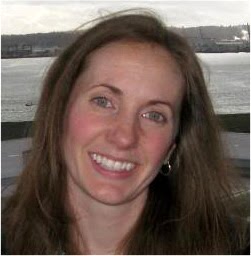Sachsenhausen Tower A, entrance to the camp
On Sunday, Jeff and I toured Sachsenhausen, a Nazi concentration camp about 20 miles from Berlin.
There is so much and yet so little that I can say about the experience. The stories, images, artifacts, and facilities themselves contain such a huge burden of history. But you know standing there before all those facts and pieces that there is no way to grasp the magnitude of it. I could write pages and pages on what we learned yesterday and it would still never capture the whole.
Sachsenhausen is not as well known as other concentration camps such as Auschwitz or Treblinka, two of the six infamous extermination centers in eastern Europe. But there are two horrible facts that make it significant nonetheless. Firstly, Sachsenhausen was designed as the model facility by the Nazis. It was built from the ground up for its terrible purposes and was held as the standard by which others operated. While the world's attention was on the 1936 Olympics in Berlin, only a few miles north slave labor was being used to construct this “thoroughly modern concentration camp”, as Heinrich Himmler proudly called it. To this end, many of the up and coming SS officials trained here and then went on to oversee other concentration and extermination camps.
Secondly, the headquarters and top officials in charge of administering all concentration camps were located just outside the gates of Sachsenhausen. From here, decisions such as food rations, medical experiments, torture practices, extermination methods, and all other aspects of camp life and death were determined for the whole system of around 20 main concentration camps and many hundreds of smaller satellite camps.
Though it was built to house around 10,000 prisoners, by 1944 it held almost 70,000. In total, over 200,000 men, women, and children were prisoners in Sachsenhausen at one time or another during its nine year span under Nazi use; 30,000 of them are estimated to have been killed or died. Terribly, the compound was used as a Soviet special camp for prisoners of war and enemies of the state for another four years after WWII, resulting in at least another 12,000 deaths from illness, malnutrition, and epidemics.
This is only the dry quantitative information; I can't begin to describe the hanging gallows, torture devices, gas chambers, crematorium, execution trenches, punitive and forced labor assignments, and the multitude of other horrors we saw and learned about. I can only say that if you ever have the chance to visit such a site, I urge you to do it.
There is so much and yet so little that I can say about the experience. The stories, images, artifacts, and facilities themselves contain such a huge burden of history. But you know standing there before all those facts and pieces that there is no way to grasp the magnitude of it. I could write pages and pages on what we learned yesterday and it would still never capture the whole.
Sachsenhausen is not as well known as other concentration camps such as Auschwitz or Treblinka, two of the six infamous extermination centers in eastern Europe. But there are two horrible facts that make it significant nonetheless. Firstly, Sachsenhausen was designed as the model facility by the Nazis. It was built from the ground up for its terrible purposes and was held as the standard by which others operated. While the world's attention was on the 1936 Olympics in Berlin, only a few miles north slave labor was being used to construct this “thoroughly modern concentration camp”, as Heinrich Himmler proudly called it. To this end, many of the up and coming SS officials trained here and then went on to oversee other concentration and extermination camps.
Secondly, the headquarters and top officials in charge of administering all concentration camps were located just outside the gates of Sachsenhausen. From here, decisions such as food rations, medical experiments, torture practices, extermination methods, and all other aspects of camp life and death were determined for the whole system of around 20 main concentration camps and many hundreds of smaller satellite camps.
Though it was built to house around 10,000 prisoners, by 1944 it held almost 70,000. In total, over 200,000 men, women, and children were prisoners in Sachsenhausen at one time or another during its nine year span under Nazi use; 30,000 of them are estimated to have been killed or died. Terribly, the compound was used as a Soviet special camp for prisoners of war and enemies of the state for another four years after WWII, resulting in at least another 12,000 deaths from illness, malnutrition, and epidemics.
This is only the dry quantitative information; I can't begin to describe the hanging gallows, torture devices, gas chambers, crematorium, execution trenches, punitive and forced labor assignments, and the multitude of other horrors we saw and learned about. I can only say that if you ever have the chance to visit such a site, I urge you to do it.






I'm glad that you all got to visit that. Quite sobering. Thank you for describing that and for adding the photos.
ReplyDelete